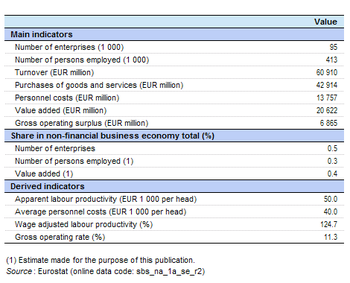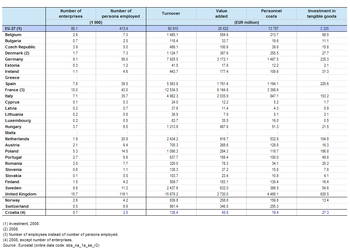Archive:Motion picture, video and TV production, sound recording and music publishing statistics - NACE Rev. 2
- Data from April 2012. Most recent data: Further Eurostat information, Main tables and Database.
This article presents an overview of statistics for the motion picture, video and TV production, sound recording and music publishing sector in the European Union (EU), as covered by NACE Rev. 2 Division 59. These activities are referred to hereafter as motion picture and sound recording activities.


(% share of sectoral total) - Source: Eurostat (sbs_na_1a_se_r2)





Main statistical findings
Structural profile
The motion picture and sound recording activities (Division 59) sector comprised 95 thousand enterprises in the EU-27 in 2009. Together they employed 413 thousand persons, equivalent to 0.3 % of all persons employed in the non-financial business economy (Sections B to J and L to N and Division 95) and 7.2 % of persons in information and communication services (Section J). They generated EUR 20 622 million of value added which was 0.4 % of the non-financial business economy total and 4.3 % of the information and communication services total.
The apparent labour productivity of the EU-27's motion picture and sound recording activities sector in 2009 was EUR 50.0 thousand per person employed, above the non-financial business economy average of EUR 41.6 thousand per person employed, but well below the information and communication services average of EUR 83 thousand per person employed. Average personnel costs within the EU-27’s motion picture and sound recording activities sector were, at EUR 40 thousand per employee, higher than the EUR 30.0 thousand per employee average for the non-financial business economy, but again were below the information and communication services average (EUR 48.6 thousand per employee). The wage-adjusted labour productivity ratio combines these two previous indicators, showing the extent to which value added per person employed covers average personnel costs per employee. This ratio stood at 124.7 % for the EU-27's motion picture and sound recording activities in 2009, which was below both the non-financial business economy average (138.8 %) and the information and communication services average (171.2 %).
The gross operating rate (the relation between the gross operating surplus and turnover) is a measure of operating profitability; it stood at 11.3 % for the EU-27’s motion picture and sound recording activities sector in 2009, somewhat higher than the non-financial business economy average of 9.7 %, but well below the information and communication services average (20.9 %). Indeed, this was the lowest level of profitability (using this measure) among the five NACE divisions for which data are available within information and communication services.
Sectoral analysis
Motion picture and sound recording activities can be split into two constituent parts. Of these, by far the larger in the EU-27 was motion picture, video and television programme activities (Group 59.1), which accounted for just over 90 % of sectoral value added and employment in 2009. The relative importance of sound recording and music publishing activities (Group 59.2) was somewhat larger in relation to the number of enterprises, with 18 900 enterprises representing almost 20 % of the sectoral total.
The difference in the level of apparent labour productivity between the two subsectors that make-up the motion picture and sound recording activities sector was fairly small. The larger motion picture, video and television programme activity subsector had EU-27 apparent labour productivity of EUR 50 thousand per person employed in 2009, while productivity for the sound recording and music publishing activities subsector was some EUR 8 thousand per person employed higher in 2008; note that the apparent labour productivity of many activities fell between 2008 and 2009 as a result of the financial and economic crisis.
EU-27 personnel costs per employee peaked at EUR 40 thousand per employee for the motion picture, video and television programme activities subsector in 2009, which was EUR 5.2 thousand per employee more than for the sound recording and music publishing activities subsector in 2008.
This combination of higher apparent labour productivity and lower average personnel costs meant that the sound recording and music publishing activities subsector had a much higher wage-adjusted labour productivity ratio (157.0 % in 2008) than the non-financial business economy (138.8 %), the motion picture and sound recording activities sector as a whole (124.7 %), or the motion picture, video and television programme activities subsector (120.0 %); the latter three figures are all for 2009.
For the gross operating rate a similar picture was observed, as the EU-27 gross operating surplus for the sound recording and music publishing activities subsector was equivalent to 14.7 % of turnover in 2009. This was well above the corresponding profitability measures that were recorded for the motion picture and sound recording activities sector (11.3 %), the smaller subsector of motion picture, video and television programme activities (10.9 %), or the non-financial business economy average (9.7 %).
Country analysis
France recorded the highest share (29.9 %) of EU-27 value added within the motion picture and sound recording activities sector in 2009, at EUR 6 165 million; this was the highest share of EU-27 value added for France in any of the non-financial business economy NACE divisions (with data available) in 2009. The French value added in this sector was almost twice as high as the level of value added in Germany – the second highest contributor to EU-27 sectoral value added (15.4 %) – while the United Kingdom was the only other Member State to report a double-digit share of the EU-27 total (13.2 %). Other measures of size, suggest that the motion picture and sound recording activities sector was relatively more important in the United Kingdom than reflected by value added, as it accounted for 28.1 % of EU-27 employment in 2009 and a 16.5 % share of the total number of enterprises within the EU-27’s motion picture and sound recording activities sector; in both of these cases the United Kingdom reported the highest share of the EU-27 total among the Member States. A more detailed breakdown shows that the relative weight of France was boosted by its high level of added value for the motion picture, video and television programme activities subsector; 31.1 % of the EU-27 total in 2009. Germany accounted for the highest share (25.6 %) of EU-27 value added for the sound recording and music publishing activities subsector.
The contribution of the motion picture and sound recording activities sector to non-financial business economy value added rose to 1.1 % in Hungary, which was considerably higher than in any of the other Member States, the second most specialised Member State was France (where the motion picture and sound recording activities sector provided 0.8 % of non-financial business economy value added).
Hungary also reported the highest wage-adjusted labour productivity ratio for motion picture and sound recording activities in 2009, at 639.7 %; this was almost four times as high as the average wage-adjusted labour productivity ratio for Hungary across the whole of the non-financial business economy. Furthermore, Hungary recorded the highest level of gross operating profitability, with its gross operating rate reaching 36.0 % in 2009 for motion picture and sound recording activities; this was 4.3 times as high as the Hungarian average for the whole of the non-financial business economy. A gross operating rate of 22.1 % was recorded for motion picture and sound recording activities in France, which was 3.4 times as high as the French average for the whole of the non-financial business economy.
At the other end of the range, the United Kingdom was the only Member State to record a wage-adjusted labour productivity ratio below 100 % in this sector, providing further evidence that the value added generated by motion picture and sound recording activities in this Member State was comparatively low in both 2008 and 2009 when compared with other indicators (such as employment) that suggested this sector was relatively developed in the United Kingdom. The relatively low level of value added in the United Kingdom resulted in a negative gross operating surplus, which in turn fed through into a gross operating rate of -11.1 % for motion picture and sound recording activities – the only negative rate among the Member States.
Data sources and availability
The analysis presented in this article is based on the main dataset for structural business statistics (SBS) which are disseminated annually. The series provides information for each Member State as well as a number of non-member countries at a detailed level according to the activity classification NACE. Data are available for a wide range of variables.
Context
This article presents an overview of statistics for the motion picture and sound recording activities sector in the EU, as covered by NACE Rev. 2 Division 59. This division includes activities related to theatrical and non-theatrical motion pictures whether on film, video tape or disc for direct projection in theatres or for broadcasting on television. These activities concern various stages from production, through post-production and distribution to projection. Buying and selling of motion picture or other film production distribution rights is also included. Post-production activities include activities such as editing, film/tape transfers, titling, subtitling, credits, closed captioning, computer-produced graphics, animation and special effects, developing and processing motion picture film and activities of motion picture film laboratories.
This division also includes sound recording activities, in other words, the production of original sound master recordings, releasing, promoting and distributing them, the publishing of music, as well as sound recording service activities in a studio or elsewhere. This activity also includes music publishing, in other words, activities of acquiring and registering copyrights for musical compositions, promoting, authorising and using these compositions in recordings, radio, television, motion pictures, live performances, print and other media. Units engaged in these activities may own the copyright or act as an administrator of the music copyrights on behalf of the copyright owners. Publishing of music and sheet books is also included.
This NACE division is composed of two groups:
- motion picture, video and television programme activities (Group 59.1);
- sound recording and music publishing activities (Group 59.2).
Excluded are film duplicating (except reproduction of motion picture film for theatrical distribution) as well as audio and video tape, CD or DVD reproduction from master copies (Division 18, part of printing and reproduction of recorded media), the wholesaling, retailing or renting of video tapes, discs and so on (Divisions 46, 47 and 77, wholesale trade, retail trade and renting and leasing of goods), television broadcasting and the creation of complete television channel programmes (Division 60, part of programming and broadcasting activities), film processing other than for the motion picture industry (Division 74, part of other professional, scientific and technical activities).
Further Eurostat information
Publications
Main tables
Database
- SBS – services (sbs_serv)
- Annual detailed enterprise statistics - services (sbs_na_serv)
- Annual detailed enterprise statistics for services (NACE Rev.2 H-N and S95) (sbs_na_1a_se_r2)
- Preliminary results on services, main indicators (NACE Rev.2) (sbs_sc_r2preli)
- SMEs - Annual enterprise statistics broken down by size classes - services (sbs_sc_sc)
- Services broken down by employment size classes (NACE Rev.2 H-N and S95) (sbs_sc_1b_se_r2)
- Annual detailed enterprise statistics - services (sbs_na_serv)
- SBS - regional data - all activities (sbs_r)
- SBS data by NUTS 2 regions and NACE Rev.2, from 2008 onwards (sbs_r_nuts06_r2)
Dedicated section
Source data for tables, figures and maps (MS Excel)
Other information
- Regulation 58/1997 of 20 December 1996 concerning structural business statistics
- Decision 2367/2002/EC of 16 December 2002 on the Community statistical programme 2003 to 2007
- Regulation 295/2008 of 11 March 2008 concerning structural business statistics